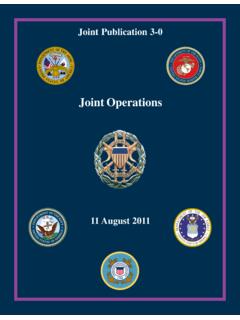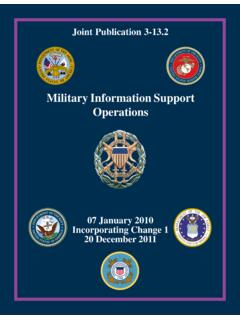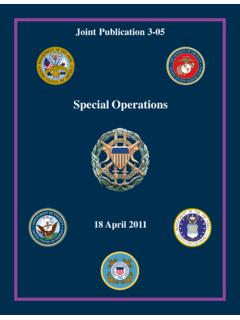Transcription of JP 3-13, Information Operations - DTIC
1 27 November 2012 Information OperationsJoint Publication 3-13i PREFACE 1. Scope This publication provides joint doctrine for the planning, preparation, execution, and assessment of Information Operations across the range of military Operations . 2. Purpose This publication has been prepared under the direction of the Chairman of the Joint Chiefs of Staff. It sets forth joint doctrine to govern the activities and performance of the Armed Forces of the United States in joint Operations and provides the doctrinal basis for US military coordination with other US Government departments and agencies during Operations and for US military involvement in multinational Operations . It provides military guidance for the exercise of authority by combatant commanders and other joint force commanders (JFCs) and prescribes joint doctrine for Operations , education, and training.
2 It provides military guidance for use by the Armed Forces in preparing their appropriate plans. It is not the intent of this publication to restrict the authority of the JFC from organizing the force and executing the mission in a manner the JFC deems most appropriate to ensure unity of effort in the accomplishment of the overall objective. 3. Application a. Joint doctrine established in this publication applies to the Joint Staff, commanders of combatant commands, subunified commands, joint task forces, subordinate components of these commands, and the Services. b. The guidance in this publication is authoritative; as such, this doctrine will be followed except when, in the judgment of the commander, exceptional circumstances dictate otherwise. If conflicts arise between the contents of this publication and the contents of Service publications, this publication will take precedence unless the Chairman of the Joint Chiefs of Staff, normally in coordination with the other members of the Joint Chiefs of Staff, has provided more current and specific guidance.
3 Commanders of forces operating as part of a multinational (alliance or coalition) military command should follow multinational doctrine and procedures ratified by the United States. For doctrine and procedures not ratified by the United States, commanders should evaluate and follow the multinational command s doctrine and procedures, where applicable and consistent with United States law, regulations, and doctrine. For the Chairman of the Joint Chiefs of Staff: CURTIS M. SCAPARROTTI Lieutenant General, Army Director, Joint Staff Preface ii JP 3-13 Intentionally Blank iii SUMMARY OF CHANGES REVISION OF JOINT PUBLICATION 3-13 DATED 13 FEBRUARY 2006 Identifies the Information environment as the aggregate of individuals, organizations, and systems that collect, process, disseminate or act on Information .
4 Defines Information -related capabilities (IRCs) as tools, techniques or activities employed within a dimension of the Information environment, which can be used to achieve a specific end(s). Introduces the Information -influence relational framework as a model illustrating the use of means and ways, through the applications of IRCs, to achieve an end(s) through influence of a target audience (TA). Defines TA as an individual or group selected for influence. Describes Information Operations (IO) as the integrated employment, during military Operations , of IRCs in concert with other lines of operation, to influence, disrupt, corrupt, or usurp the decision making of adversaries and potential adversaries while protecting our own. Designates the IO staff as the combatant command focal point for IO and the IO cell as the planning element responsible for integration and synchronization of IRCs to achieve national or combatant commander objectives against adversaries or potential adversaries.
5 Emphasizes IO must be integrated into all steps of the joint operation planning process. Articulates that it is vital to integrate multinational partners into joint IO planning, in order to gain agreement on an integrated and achievable IO strategy. Summary of Changes iv JP 3-13 Intentionally Blank v TABLE OF CONTENTS PAGE EXECUTIVE SUMMARY .. vii CHAPTER I OVERVIEW Introduction.
6 I-1 The Information Environment .. I-1 The Information and Influence Relational Framework and the Application of Information -Related Capabilities .. I-3 CHAPTER II Information Operations Introduction ..II-1 Terminology ..II-1 Information Operations and the Information -Influence Relational Framework ..II-1 The Information Operations Staff and Information Operations Cell ..II-2 Relationships and Integration ..II-5 CHAPTER III AUTHORITIES, RESPONSIBILITIES, AND LEGAL CONSIDERATIONS Introduction .. III-1 Authorities .. III-1 Responsibilities .. III-1 Legal Considerations .. III-3 CHAPTER IV INTEGRATING Information -RELATED CAPABILITIES INTO THE JOINT OPERATION PLANNING PROCESS Introduction .. IV-1 Information Operations Planning .. IV-1 Information Operations Phasing and Synchronization.
7 IV-11 CHAPTER V multinational Information Operations Introduction .. V-1 Other Nations and Information Operations .. V-2 multinational Information Operations Considerations .. V-2 Planning, Integration, and Command and Control of Information Operations in multinational Operations .. V-3 Table of Contents vi JP 3-13 multinational Organization for Information Operations Planning .. V-5 multinational Policy Coordination.
8 V-5 APPENDIX A References .. A-1 B Administrative Instructions ..B-1 GLOSSARY Part I Abbreviations and Acronyms .. GL-1 Part II Terms and Definitions .. GL-3 FIGURE I-1 The Information Environment .. I-2 I-2 Target Audiences .. I-4 I-3 Application of Means to Achieve I-6 I-4 Application of Information -Related Capabilities to Achieve Influence .. I-7 I-5 Influence Leads to Achievement of an End(s) .. I-8 II-1 Notional Operation Plan Phases ..II-2 II-2 Information Operations Cell Chief Functions ..II-5 II-3 Notional Information Operations Cell ..II-6 II-4 Notional Joint Interagency Coordination Group Structure ..II-8 II-5 Notional Joint Intelligence Support Element and Joint Intelligence Operations Center.
9 II-11 IV-1 Information Operations Planning within the Joint Operation Planning Process .. IV-3 IV-2 Examples of Measures of Performance Feedback .. IV-8 IV-3 Possible Sources of Measures of Effectiveness Feedback .. IV-9 V-1 Information Operations in the multinational Environment .. V-1 V-2 Notional multinational Information Operations Coordination Board .. V-4 vii EXECUTIVE SUMMARY COMMANDER S OVERVIEW Provides an Overview of Information Operations (IO) and the Information Environment Describes IO and Its Relationships and Integration Addresses IO Authorities, Responsibilities, and Legal Considerations Explains Integrating Information -Related Capabilities into the Joint Operation Planning Process Covers multinational Information Operations Overview The ability to share Information in near real time, anonymously and/or securely, is a capability that is both an asset and a potential vulnerability to us, our allies, and our adversaries.
10 The instruments of national power (diplomatic, informational, military, and economic) provide leaders in the US with the means and ways of dealing with crises around the world. Employing these means in the Information environment requires the ability to securely transmit, receive, store, and process Information in near real time. The nation s state and non-state adversaries are equally aware of the significance of this new technology, and will use Information -related capabilities (IRCs) to gain advantages in the Information environment, just as they would use more traditional military technologies to gain advantages in other operational environments. As the strategic environment continues to change, so does Information Operations (IO).






